
Keep your intake clean! Ford Focus ST Catch Can R&D, Part 1: Initial Prototype and Project Direction
Interested in picking up this awesome catch can system? Check out our product page for more details.
Mishimoto Ford Focus ST Baffled Oil Catch Can Kit

Ford Focus ST test vehicle
As you may be aware, our engineering team has been wrenching away on this Focus ST to develop a slew of awesome products for the community. Our oil cooler development is underway, and alongside this project we began to experiment with a direct-fit oil catch can system. Now, you may be wondering exactly how necessary such a product is.
Discussions around the community have covered the impact of oil within the intake system and its effect on valve buildup. In short, the lack of port injection (the EcoBoost uses direct injection) results in much of the oil within the intake system coating your valves. In a port-injection engine, the fuel passing over the valves works as a cleaning agent to prevent buildup. Without this happening, these buildups can restrict airflow and cause turbulence to airflow prior to entry into the combustion chamber.
Why is oil in my intake? Your ST features a complex CCV (crankcase ventilation) system. Two primary lines make up the CCV system equipped on the EcoBoost engine. The first, the breather air line, routes from the valve cover to the intake piping. This line provides a light vacuum on the crankcase and is most used during wide-open throttle situations. The second, the ventilation line, routes from the side of the engine block to the intake manifold. This line utilizes the PCV (positive crankcase ventilation) valve and features a higher vacuum source than the makeup air line. The ventilation line is used during idle and part-throttle driving situations. The in-line valve works to eliminate the pressure from the intake manifold from reaching the crankcase. These two hoses/lines will function together to provide optimal crankcase pressures for efficient operation. Engines typically function better with a slight vacuum on the crankcase.
Now, valve coking is not the end of the world and can certainly be cleaned. That said, preventive maintenance is always a great idea, especially if you intend to own your ST for quite some time. We recently developed a catch-can setup for the new EcoBoost Mustang, and we saw some substantial fluid accumulations after a small amount of mileage. We expect similar results with the Focus!
Initial Inspection
Both online research and previous projects tell us that the primary culprit for oil contamination is the PCV line. The ST is equipped with a PCV line that comes off a plate on the front of the engine block and routes to the intake manifold. The inline valve opens and closes to bleed pressure from the crankcase without introducing positive pressure (boost) from the intake manifold.
On the ST, this line is located under the intake manifold, necessitating removal of the manifold to fully evaluate the setup. Luckily this is quite an easy task and we had the manifold off in no time.
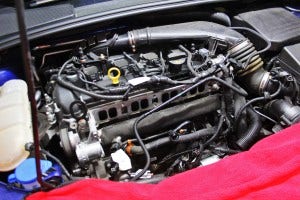
Intake manifold removed
Before looking at the PCV line itself, it we found that oil was very certainly present within the intake system on this vehicle that has been driven 16,000 miles.
First, we found a decent amount of oil residue lingering right around the throttle body.
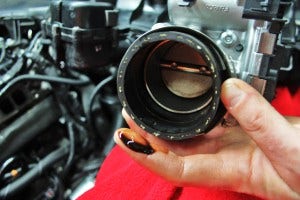
Throttle body oil contamination
Next, peering into the PCV line revealed some additional oil which would eventually make it into the manifold of this vehicle.
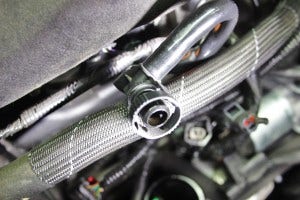
PCV line oil buildup
And finally, we peeked into a few of the valve ports to see what kind of buildup this ST already had. Not entirely surprising, these valves are pretty well coked with buildup.
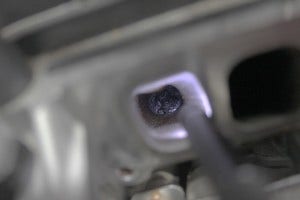
Focus ST valve buildup
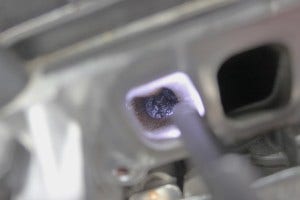
Focus ST valve buildup

Focus ST valve buildup
This was evidence enough to necessitate a solution to slow the progress of valve buildups. An effective catch-can solution should aid in keeping these valves cleaner for a longer time.
PCV Line
As we noted, our team hypothesizes that this particular line is going to produce the greatest amount of fluid/byproduct accumulation. After removing the intake manifold, this port is easily viewed.
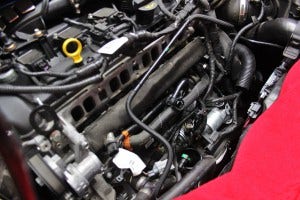
Focus ST PCV line
And here's a close-up shot of this line.
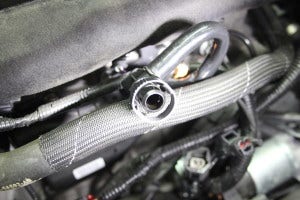
Focus ST PCV line
The quick connect fitting you see in the last image connects to a port on the intake manifold itself. The other end of this line also features a quick-disconnect fitting and mates with the PCV plate on the engine block. This is similar to the Mustang EcoBoost setup, although the connections are slightly different.
Our plan with this line was to remove the connections from the line and mate them to our silicone lines. We could then run one line from the PCV plate to our catch can, and the second line from the catch can to the intake manifold. This would maintain functionality of the PCV system and offer the separation properties of having a catch can within the system.
Breather Line
On the ST, the breather line routes from the corner of the valve cover to the intake piping via a short hose. As with the PCV line, this port also uses a quick-disconnect fitting. The location is referenced in the image below.
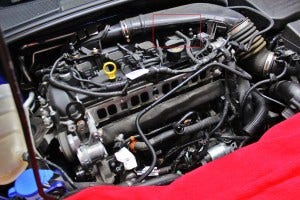
Focus ST breather line
We will also be splicing into this line, which routes from the valve cover port to our catch can, and then from our catch can to the intake.
Can Mockup and Results
Before we jumped into a final product, we wanted to verify that each line needed to be addressed and treated to a catch can. Throwing a catch can within the breather line would be foolish if no accumulation ever actually appeared. Not only would it be a waste of resources, but our customers may be a bit upset knowing they could have simply gone with a single can setup.
We selected a can location near the connection point on the hot-side intercooler pipe. Our bracket attachment point would be an open ear on the transmission. This mounting point will provide ample stability to support one or two of our catch can units.
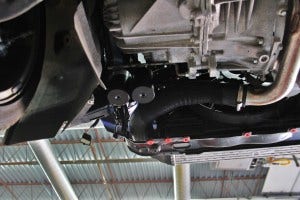
Catch can mockup
The location selected also provides short line routes that can be routed in a way that would not clutter the engine bay. In fact, the system is nearly unidentifiable once installed, keeping with our plans to make this a stock-appearing setup.
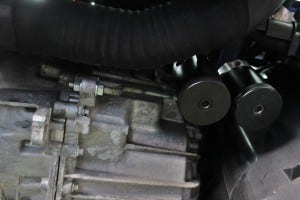
Catch can mockup
This location will provide access to draining upon normal servicing. When you change your oil, you can also easily empty the contents of the catch can.
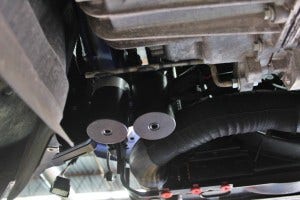
Catch can mock-up
Do keep in mind that this bracket is a very, very rough prototype. It is in place to collect some quick data for fluid accumulation per line. Our final bracket will be much more refined, but our plan is to mount it to the same attachment point.
Mishimoto Baffled Catch Can
One of the key components within this kit is the catch can itself. Without an efficient can, offering a direct-fit kit would seem foolish. We have been using our compact baffled catch can in a variety of direct-fit kits. Check out a shot of the internals below!
As you can see, we use an internal baffle as well as a bronze filter. Basic specs are noted below.
- 100% billet 6061 aluminum sealed can
- 50 micron bronze filter
- Serviceable filter
- Removable plug on base of can for fluid removal
- Internal air diverter turbulates air longer for improved separation
The internal baffling works as a dual-purpose component. First, it provides additional internal surface area for fluid condensation. Second, the baffle prevents fluid within the can from sloshing about during cornering or bumpy terrain.
Initial Testing Results
This mockup system was installed on our test vehicle immediately after it arrived. We then put some miles on the car in an attempt to build up accumulation from each line. We kept this system in place during our oil cooler testing in order to maximize mileage on the system and obtain the best results possible.
Once we had accumulated some mileage, we removed the base for each catch can to evaluate our byproduct. As our engineers had assumed, the breather line was completely dry. Although it had the scent of oil, there was no moisture present in the can.
Opening the PCV can revealed some buildup, actually much more than we expected for such a short time period (Less than 100 miles).
Check out a few shots!
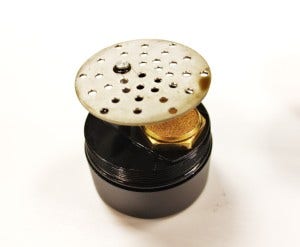
PCV catch can accumulation
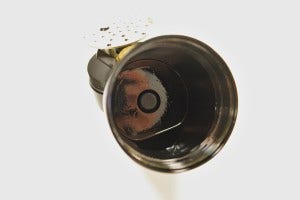
PCV catch can accumulation
I'd say a catch can is a good idea!
Coming Up!
Now that we had settled on the bracket location, a target CCV line, and our catch can selection, we could make a more appropriate bracket prototype. Check back for a look at the fabrication of this component as well as our plans for collecting more testing data.
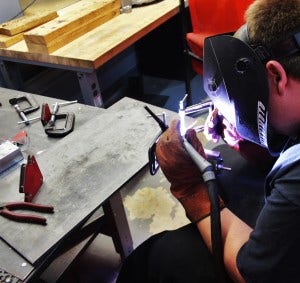
Catch can bracket fabrication
Thanks for reading!
-John




